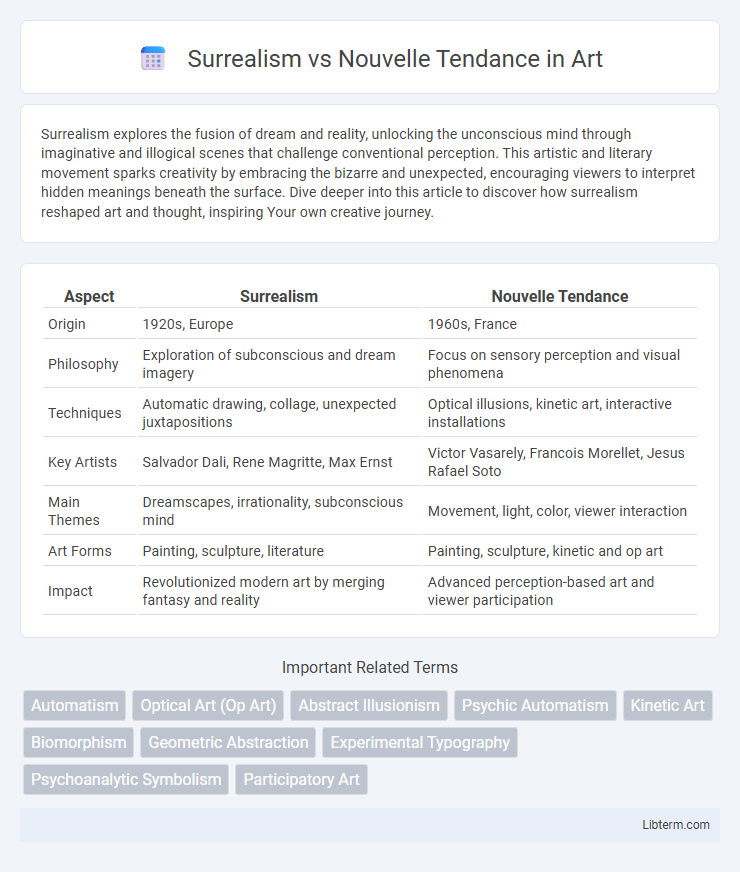Surrealism explores the fusion of dream and reality, unlocking the unconscious mind through imaginative and illogical scenes that challenge conventional perception. This artistic and literary movement sparks creativity by embracing the bizarre and unexpected, encouraging viewers to interpret hidden meanings beneath the surface. Dive deeper into this article to discover how surrealism reshaped art and thought, inspiring Your own creative journey.
Table of Comparison
| Aspect | Surrealism | Nouvelle Tendance |
|---|---|---|
| Origin | 1920s, Europe | 1960s, France |
| Philosophy | Exploration of subconscious and dream imagery | Focus on sensory perception and visual phenomena |
| Techniques | Automatic drawing, collage, unexpected juxtapositions | Optical illusions, kinetic art, interactive installations |
| Key Artists | Salvador Dali, Rene Magritte, Max Ernst | Victor Vasarely, Francois Morellet, Jesus Rafael Soto |
| Main Themes | Dreamscapes, irrationality, subconscious mind | Movement, light, color, viewer interaction |
| Art Forms | Painting, sculpture, literature | Painting, sculpture, kinetic and op art |
| Impact | Revolutionized modern art by merging fantasy and reality | Advanced perception-based art and viewer participation |
Introduction to Surrealism and Nouvelle Tendance
Surrealism emerged in the early 1920s as an avant-garde movement emphasizing dream-like imagery and the unconscious mind, championed by artists like Andre Breton and Salvador Dali. Nouvelle Tendance, originating in the 1960s, focused on kinetic art, optical illusions, and scientific approaches to perception, led by figures such as Victor Vasarely and Francois Morellet. Both movements challenged traditional art forms but diverged in their exploration of subconscious expression versus systematic visual experimentation.
Historical Contexts: Origins and Development
Surrealism emerged in the early 1920s in Paris, rooted in the aftermath of World War I and influenced by psychoanalysis and the subconscious exploration championed by Andre Breton. Nouvelle Tendance originated in the late 1950s in Europe, particularly Yugoslavia, as a reaction against abstract expressionism and an embrace of kinetic and Op Art, focusing on optical effects and viewer interaction. Both movements reflect distinct historical responses to societal changes: Surrealism reacting to war trauma with dreamlike imagery, while Nouvelle Tendance embraced scientific advancements and technological experimentation during the post-war period.
Key Philosophies and Artistic Aims
Surrealism centers on exploring the unconscious mind, dreams, and irrational juxtapositions to challenge reality and unlock creative potential. Nouvelle Tendance emphasizes kinetic art, optical illusions, and viewer interaction to redefine perception and engage audiences through dynamic visual experiences. Both movements reject traditional representation but diverge in focus: Surrealism probes psychological depths, while Nouvelle Tendance investigates perception and sensory stimulation.
Influential Artists and Major Works
Surrealism, led by artists like Salvador Dali and Rene Magritte, revolutionized visual art through iconic works such as Dali's "The Persistence of Memory" and Magritte's "The Treachery of Images," emphasizing dream-like, subconscious imagery. Nouvelle Tendance, emerging in the 1960s with key figures like Enrico Castellani and Piero Manzoni, focused on conceptual and kinetic art, pushing boundaries with works like Manzoni's "Achromes" and Castellani's monochrome reliefs. Both movements profoundly influenced modern art by challenging traditional aesthetics and exploring new artistic expressions.
Techniques and Artistic Processes
Surrealism employs automatic drawing, dream analysis, and juxtaposition of unexpected elements to unlock the subconscious mind and explore irrational imagery. Nouvelle Tendance emphasizes kinetic and optical art techniques, utilizing repetition, modular forms, and viewer interaction to create dynamic visual experiences based on perception and movement. Both movements prioritize experimental processes but diverge in their focus on subconscious symbolism versus systematic, sensory engagement.
Visual Language: Symbolism vs. Structure
Surrealism employs a visual language rich in symbolism, using dreamlike, fantastical imagery to unlock the unconscious mind and explore irrational juxtapositions. Nouvelle Tendance, by contrast, emphasizes structured, systematic compositions grounded in geometric forms and repetitive patterns to convey order and objectivity. The symbolic ambiguity of Surrealism contrasts sharply with Nouvelle Tendance's focus on spatial relationships and formal clarity in visual communication.
Reception and Critique in Art Circles
Surrealism, emerging in the 1920s, was widely embraced in art circles for its exploration of the unconscious and dream imagery, influencing prominent artists like Salvador Dali and Rene Magritte while receiving both acclaim and skepticism for its radical departure from realism. Nouvelle Tendance, a 1960s movement rooted in Op Art and Kinetic Art, garnered mixed reception as critics debated its reliance on optical illusion and scientific concepts versus emotional expression. Both movements sparked intense discourse on the boundaries of artistic innovation, with Surrealism praised for its psychological depth and Nouvelle Tendance critiqued for its perceived detachment from traditional aesthetics.
Impact on Contemporary Art Movements
Surrealism pioneered the exploration of the unconscious mind, profoundly influencing contemporary art movements by encouraging artists to delve into dreamlike, irrational imagery and embrace automatism. Nouvelle Tendance, emerging in the 1960s, shifted focus toward kinetic art and viewer interaction, laying groundwork for participatory and technological art forms. Both movements expanded artistic boundaries, with Surrealism inspiring conceptual and abstract expressions and Nouvelle Tendance advancing multimedia and interactive installations in contemporary art.
Global Influence and Cultural Interpretations
Surrealism, originating in the early 20th century, profoundly influenced global art by integrating dreamlike imagery and subconscious exploration, shaping movements in literature, film, and visual arts across Europe and the Americas. Nouvelle Tendance, emerging in the 1960s, focused on optical illusions and kinetic art, emphasizing scientific principles and technological innovation, impacting the evolution of interactive and multimedia art worldwide. Both movements reflect distinct cultural interpretations: Surrealism's exploration of the unconscious contrasts with Nouvelle Tendance's emphasis on perceptual phenomena, highlighting diverse responses to global modernity and artistic experimentation.
Conclusion: Legacy and Ongoing Relevance
Surrealism reshaped modern art by championing the unconscious and dream imagery, influencing literature, cinema, and visual arts with its avant-garde techniques. Nouvelle Tendance emphasized interactivity and kinetic art, pioneering media and technology integration that prefigured contemporary digital and installation art. Both movements' legacies persist in their challenge to traditional forms, inspiring ongoing innovation and critical discourse in the art world.
Surrealism Infographic

 libterm.com
libterm.com